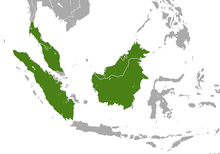Malayan weasel
The Malayan weasel (Mustela nudipes) or Malay weasel is a weasel species native to the Thai-Malay Peninsula and the islands of Sumatra and Borneo. It is listed as Least Concern on the IUCN Red List.[1]
| Malayan weasel | |
|---|---|
| Scientific classification | |
| Kingdom: | Animalia |
| Phylum: | Chordata |
| Class: | Mammalia |
| Order: | Carnivora |
| Family: | Mustelidae |
| Genus: | Mustela |
| Species: | M. nudipes |
| Binomial name | |
| Mustela nudipes Desmarest, 1822 | |
 | |
| Distribution of the Malayan weasel | |
Description
Malayan weasels have a body length of 12–14 inches (30–36 cm) and a tail length of 9.4–10.2 inches (24–26 cm). The body is reddish-brown to grayish-white. The head is a much lighter color than the rest of the body. The distal half of the tail is pale orange to white. There is no hair on the soles of the feet around the pads.[2]
Habitat
The Malayan weasel is generally associated with tropical lowland forest, but has been recorded in habitats ranging from swamp and montane forests to plantations and high elevation montane scrub up to 5,600 feet (1,700 m).[2]. A better understanding of habitat preferences would require surveys specifically aimed at Malayan Weasels because the species is rarely detected by general camera-trap, road mortality, and visual surveys.[3]
Ecology and behavior
The Malayan weasel is very poorly known, but assumed to occur at low densities and behave elusively based on low detection rates. It is a ground-living species and its morphology not suited to climbing. Their diet is unknown but assumed to be similar to other small weasels: mostly carnivorous, including small rodents, birds, eggs, and small herptiles. Most records of the species occurred during the day, but more research is needed to determine whether Malayan weasels are also active nocturnally. The majority of sightings have been of single animals, suggesting a solitary nature as seen in most weasel species of genus Mustela. Not much is known about its breeding habits, but a litter of four has been recorded.[3] [2]
Relationship with humans
Records of Malayan weasels in highly degraded forests, plantations, and even suburban areas suggest that the species is tolerant of humans. Malayan weasels are sometimes killed by villagers for medicinal use, food, trophy, fur, for killing chickens, and incidental by-catch in snares. Regardless, in some areas they are seen positively and allowed in villages as a predator of crop-raiding rats. The wide range of the species across various habitats and tolerance of humans suggests resilience to local habitat conversion. Though overall numbers are stable, Malayan weasels are protected in peninsular Malaysia and Thailand due to local declines.[3]
References
- Duckworth, J. W.; Chutipong, W.; Hearn, A. & Ross, J. (2015). "Mustela nudipes". The IUCN Red List of Threatened Species. IUCN. 2015: e.T41657A45214257. doi:10.2305/IUCN.UK.2015-4.RLTS.T41657A45214257.en.
- Luke Hunter (2011). Carnivores of the World. New Holland Publishers.
- Duckworth, J.W.; Lee, B.; Meijaard, E.; Meiri, S. (2006). "The Malay weasel Mustela nudipes: distribution, natural history and a global conservation status review" (PDF). Small Carnivore Conservation. IUCN. 34 (35): 2–21.
